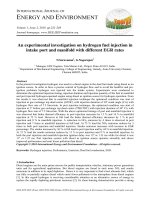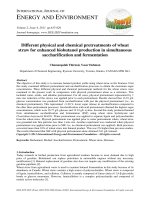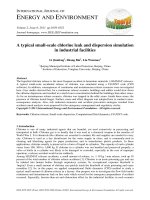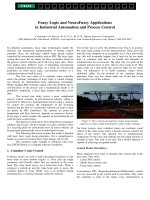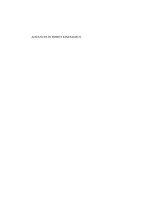zeolites in industrial separation and catalysis - wiley
Bạn đang xem bản rút gọn của tài liệu. Xem và tải ngay bản đầy đủ của tài liệu tại đây (7.66 MB, 619 trang )
Edited by
Santi Kulprathipanja
Zeolites in Industrial Separation
and Catalysis
Edited by
Santi Kulprathipanja
Zeolites in Industrial Separation
and Catalysis
Further Reading
R. Xu, W. Pang, J. Yu, Q. Huo, J. Chen
Chemistry of Zeolites and
Related Porous Materials
Synthesis and Structure
2007
ISBN: 978-0-470-82233-3
I. Chorkendorff, J.W. Niemantsverdriet
Concepts of Modern
Catalysis and Kinetics
2007
ISBN: 978-3-527-31672-4
B. Cornils, W.A. Herrmann, M. Muhler,
C H. Wong (Eds.)
Catalysis from A to Z
A Concise Encyclopedia
2007
ISBN: 978-3-527-31438-6
S.M. Roberts
Catalysts for Fine Chemical
Synthesis
Volume 4. Microporous and
Mesoporous Solid Catalysts
2006
ISBN: 978-0-471-49054-8
R.A. van Santen, M. Neurock
Molecular Heterogeneous
Catalysis
A Conceptual and Computational
Approach
2006
ISBN: 978-3-527-29662-0
J. Hagen
Industrial Catalysis
A Practical Approach
2006
ISBN: 978-3-527-31144-6
F. Schüth, K.S.W. Sing, J. Weitkamp
(Eds.)
Handbook of Porous Solids
5 Volumes
2002
Hardcover
ISBN: 978-3-527-30246-8
Edited by
Santi Kulprathipanja
Zeolites in Industrial Separation
and Catalysis
The Editor
Dr. Santi Kulprathipanja
UOP, A Honeywell Company
25 E. Algonquin Road
Des Plaines, IL 60017
USA
All books published by Wiley-VCH are carefully
produced. Nevertheless, authors, editors, and
publisher do not warrant the information
contained in these books, including this book, to
be free of errors. Readers are advised to keep in
mind that statements, data, illustrations,
procedural details or other items may
inadvertently be inaccurate.
Library of Congress Card No.: applied for
British Library Cataloguing-in-Publication Data
A catalogue record for this book is available from
the British Library.
Bibliographic information published by the
Deutsche Nationalbibliothek
The Deutsche Nationalbibliothek lists this
publication in the Deutsche Nationalbibliografi e;
detailed bibliographic data are available on the
Internet at
© 2010 WILEY-VCH Verlag GmbH & Co.
KGaA, Weinheim
All rights reserved (including those of translation
into other languages). No part of this book may
be reproduced in any form – by photoprinting,
microfi lm, or any other means – nor transmitted
or translated into a machine language without
written permission from the publishers.
Registered names, trademarks, etc. used in this
book, even when not specifi cally marked as such,
are not to be considered unprotected by law.
Cover Design Formgeber, Eppelheim
Typesetting Toppan Best-set Premedia Limited
Printing and Binding Bell & Bain Ltd., Glasgow
Printed in Great Britain
Printed on acid-free paper
ISBN: 978-3-527-32505-4
V
Zeolites in Industrial Separation and Catalysis. Edited by Santi Kulprathipanja
Copyright © 2010 WILEY-VCH Verlag GmbH & Co. KGaA, Weinheim
ISBN: 978-3-527-32505-4
Contents
Preface XIX
List of Contributors XXIII
1 Introduction 1
Edith M. Flanigen, Robert W. Broach, and Stephen T. Wilson
1.1 Introduction 1
1.1.1 Molecular Sieves and Zeolites 1
1.1.2 Nomenclature 2
1.1.3 Early History 3
1.1.4 Natural Zeolites 4
1.2 History of Molecular Sieve Materials 5
1.2.1 Aluminosilicate Zeolites and Silica Molecular Sieves 6
1.2.2 The Materials Explosion Since the 1980s 7
1.2.2.1 The 1980s 7
1.2.2.2 The 1990s 11
1.2.2.3 The New Millennium 14
1.3 Synthesis 15
1.4 Applications 16
1.5 Markets 17
1.6 The Future 17
1.6.1 Materials 17
1.6.2 Applications 18
1.7 History of International Conferences and Organizations 18
1.8 Historical Epilog 20
References 20
Further Reading 26
2 Zeolite Types and Structures 27
Robert W. Broach
2.1 Introduction 27
2.2 Building Units for Zeolite Frameworks 28
VI Contents
2.3 Zeolite Framework Types 31
2.4 Pores, Channels, Cages and Cavities 32
2.5 Materials Versus Framework Types 34
2.6 Structures of Commercially Signifi cant Zeolites 35
2.6.1 Linde Type A (LTA) 36
2.6.2 Faujasite (FAU) 38
2.6.3 Mordenite (MOR) 40
2.6.4 Chabazite (CHA) 42
2.6.5 ZSM-5 (MFI) 45
2.6.6 Linde Type L (LTL) 47
2.6.7 Beta Polymorphs *BEA and BEC 49
2.6.8 MCM-22 (MWW) 51
2.7 Hypothetical Zeolite Frameworks 54
Acknowledgments 55
References 55
3 Synthesis of Zeolites and Manufacture of Zeolitic Catalysts
and Adsorbents 61
Robert L. Bedard
3.1 Introduction 61
3.2 Synthesis of Zeolites and Aluminophosphate Molecular Sieves 62
3.2.1 Hydrothermal Synthesis – The Key to Metastable Phases 62
3.2.2 Typical Zeolite Syntheses 63
3.2.3 Important Synthesis Parameters – Zeolites 65
3.2.4 Typical Aluminophosphate Syntheses 66
3.2.5 Important Synthesis Parameters – Aluminophosphates 67
3.2.6 Dewatering, Filtration and Washing of Molecular Sieve Products 67
3.3 Forming Zeolite Powders into Usable Shapes 68
3.3.1 Chemical Engineering Considerations in Zeolite Forming 68
3.3.2 Ceramic Engineering Considerations in Zeolite Forming 69
3.3.3 Bound Zeolite Forms 70
3.3.4 Other Zeolite Forms – Colloids, Sheets, Films and Fibers 70
3.4 Finishing: Post-Forming Manufacturing of Zeolite Catalysts and
Adsorbents 71
3.4.1 Post-Forming Crystallization 71
3.4.2 Stabilization and Chemical Modifi cation of Zeolites 72
3.4.3 Ion Exchange and Impregnation 74
3.4.4 Drying and Firing 75
3.5 Selected New Developments in Catalyst and Adsorbent Manufacture 75
References 77
4 Zeolite Characterization 85
Steven A. Bradley, Robert W. Broach, Thomas M. Mezza, Sesh Prabhakar,
and Wharton Sinkler
4.1 Introduction 85
4.1.1 Importance of Characterization 85
Contents VII
4.2 Multi-Technique Methodology 86
4.2.1 Identifi cation of the Structure of a Newly Invented Zeolite 86
4.3 X-Ray Powder Diffraction Characterization of Zeolitic Systems 91
4.3.1 Interpretation of Powder Diffraction Data for Zeolites 91
4.3.2 Phase Identifi cation and Quantifi cation 92
4.3.3 Unit Cell Size Determination 94
4.3.4 Crystallite Size 95
4.3.5 Rietveld Refi nement 96
4.4 Electron Microscopy Characterization of Zeolitic Systems 97
4.4.1 Importance of Electron Microscopy for Characterizing
Zeolites 97
4.4.2 Scanning Electron Microscopy 98
4.4.2.1 Morphological Characterization 98
4.4.2.2 Compositional Characterization 100
4.4.3 Transmission Electron Microscopy 104
4.4.3.1 Sample Preparation 104
4.4.3.2 Structural Characterization 105
4.4.3.3 Morphological Characterization 106
4.4.3.4 Compositional Characterization 108
4.4.3.5 STEM Application to Metals in Zeolites and Coke Analysis 109
4.5 Infrared Spectroscopy Characterization of Zeolitic Systems 111
4.5.1 Introduction to Infrared Spectroscopy 111
4.5.2 Modes of Measurement 112
4.5.3 Framework IR 114
4.5.3.1 Zeolite Structure 115
4.5.3.2 Tracking Zeolite Framework Si/Al 116
4.5.3.3 Zeolite Synthesis 118
4.5.4 Methods Requiring Sample Pretreatment 119
4.5.5 Hydroxyl IR 120
4.5.6 Acidity 123
4.5.6.1 General Theory 124
4.5.6.2 Selection of Probe Molecules 125
4.5.6.3 Quantitation of Sites 125
4.5.6.4 Pyridine Adsorption 127
4.5.6.5 Ammonia 130
4.5.6.6 Low-Temperature Acidity Probes 131
4.5.6.7 Carbon Monoxide 132
4.5.6.8 Nitrogen (N
2
) 134
4.5.6.9 Measurement of External Acidity 134
4.5.6.10 Other Probes 135
4.5.7 In Situ/In Operando Studies 136
4.5.8 Characterization of Metal-Loaded Zeolites 136
4.5.8.1 Cation Exchange for Adsorption/Separation 137
4.5.8.2 Metal-Loading for Catalysis 138
4.5.8.3 Noble Metal-Loading for Catalysis 138
4.5.8.4 Non-Noble Metal-Loading for Catalysis 139
VIII Contents
4.6 NMR Characterization of Zeolitic Systems 140
4.6.1 Introduction to NMR 140
4.6.1.1 Spin-Half Nuclei 142
4.6.1.2 Cross Polarization 142
4.6.1.3 Quadrupolar Nuclei 143
4.6.1.4 Dipolar Recoupling 143
4.6.1.5 Pulsed Field Gradient NMR – diffusion 144
4.6.2 Applications 145
4.6.2.1
29
Si NMR 145
4.6.2.2
27
Al NMR 147
4.6.2.3
31
P NMR 149
4.6.2.4
1
H NMR 150
4.6.2.5
17
O and Other Nuclei 151
4.6.2.6 Diffusion of Hydrocarbons in Zeolites 151
4.7 Physical/Chemical Characterization 152
4.7.1 Nitrogen Physisorption 152
4.7.2 Thermal and Mechanical Analyses 154
4.7.3 Adsorption Capacity 156
4.7.4 Acid Sites 157
4.8 Conclusions 158
4.8.1 Future Characterization Directions 158
References 160
5 Overview in Zeolites Adsorptive Separation 173
Santi Kulprathipanja and Robert B. James
5.1 Introduction 173
5.2 Industrial Adsorptive Separation 173
5.2.1 Gas Separation 173
5.2.2 Liquid Separation 174
5.2.2.1 Aromatics 174
5.2.2.2 Non-Aromatic Hydrocarbons 174
5.2.2.3 Non-Petrochemicals 175
5.2.2.4 Trace Component Removal 175
5.3 R&D Adsorptive Separation 176
5.3.1 Aromatic Hydrocarbon Separation 176
5.3.2 Non-Aromatic Hydrocarbon Separation 176
5.3.3 Carbohydrate Separation 176
5.3.4 Pharmaceutical Separation 176
5.3.5 Trace Impurities Removal 176
5.3.5.1 Sulfur Removal 176
5.3.5.2 Oxygenate Removal 188
5.3.5.3 Nitrogenate Removal 190
5.3.5.4 Iodide Removal 190
5.3.5.5 Aromatic Removal 190
5.3.5.6 Metal Removal 190
Contents IX
5.4 Summary Review of Zeolites in Adsorptive Separation 191
Acknowledgments 192
References 192
6 Aspects of Mechanisms, Processes, and Requirements for
Zeolite Separation 203
Santi Kulprathipanja
6.1 Introduction 203
6.2 Impacts of Adsorptive Separation Versus Other Separation
Processes 203
6.3 Liquid Phase Adsorption 206
6.3.1 Sanderson’s Model of Intermediate Electronegativity 207
6.4 Modes of Operation 208
6.4.1 Adsorption Isotherms 209
6.4.2 Pulse Test Procedure 209
6.4.3 Breakthrough Procedure 210
6.5 Zeolite Separation Processes 211
6.5.1 Equilibrium-Selective Adsorption 211
6.5.1.1 Zeolite Framework Structure 212
6.5.1.2 Metal Cation Exchanged in Zeolite 212
6.5.1.3 Zeolite SiO
2
/Al
2
O
3
Molar Ratio 216
6.5.1.4 Moisture Content in Zeolite 218
6.5.1.5 Characteristics of the Desorbent 219
6.5.1.6 Operating Temperature 220
6.5.1.7 Operating Pressure 221
6.5.2 Rate-Selective Adsorption 221
6.5.3 Shape-Selective Adsorption 222
6.5.4 Ion Exchange 223
6.5.4.1 Ion Exchange Capacity 224
6.5.4.2 Ion Exchange Selectivity 224
6.5.4.3 Kinetics 224
6.5.5 Reactive Adsorption 224
6.6 Summary 225
Acknowledgments 225
References 226
7 Liquid Industrial Aromatics Adsorbent Separation 229
Stanley J. Frey
7.1 Introduction 229
7.2 Major Industrial Processes 231
7.2.1 p-Xylene 231
7.2.1.1 Industrial Uses and Demand 231
7.2.1.2 Method of Production 232
7.2.1.3 Characteristics of Zeolitic Adsorptive Process 235
7.2.2 m-Xylene 241
X Contents
7.2.2.1 Industrial Uses and Demand 241
7.2.2.2 Method of Production 241
7.2.2.3 Characteristics of Zeolitic Adsorptive Process 242
7.3 Other Signifi cant Processes 243
7.3.1 2,6-Dimethylnaphthalene 244
7.3.1.1 Industrial Uses and Demand 244
7.3.1.2 Method of Production 244
7.3.2 Ethylbenzene 244
7.3.2.1 Industrial Uses and Demand 244
7.3.2.2 Method of Production 244
7.3.3 p-Cresol 245
7.3.3.1 Industrial Uses and Demand 245
7.3.3.2 Method of Production: Adsorbent–Desorbent 245
7.4 Summary 245
References 246
8 Liquid Industrial Non-Aromatics Adsorptive Separations 249
Stephen W. Sohn
8.1 Introduction 249
8.2 Normal Paraffi n Separations 249
8.2.1 Characteristics of Adsorbent for Normal Paraffi n
Extraction 250
8.2.1.1 Selectivity 250
8.2.1.2 Capacity 251
8.2.1.3 Mass Transfer Rate 252
8.2.1.4 Stability 252
8.2.1.5 Zeolite Types 252
8.2.2 Desorbent Critical Characteristics 253
8.2.2.1 Selectivity 254
8.2.2.2 Compatibility 254
8.2.2.3 Ease of Separation 254
8.2.2.4 Availability 255
8.2.2.5 Reactivity 255
8.2.3 Simulated Moving Bed Operation: Sorbex Process 256
8.2.3.1 Adsorbent Allocation within the Molex Process 256
8.2.3.2 Critical Sorbex Zone Parameters 257
8.2.4 Light Normal Paraffi n Separation (Gasoline Range nC
5–6
) 258
8.2.4.1 Industrial Use and Demand 258
8.2.4.2 Unique Operating Parameters 258
8.2.5 Intermediate Normal Paraffi n Separation (C
6–10
) 260
8.2.5.1 Industrial Use and Demand 260
8.2.5.2 Unique Operating Parameters 260
8.2.6 Heavy Normal Paraffi n Separation (C
10–18
) 261
8.2.6.1 Industrial Use and Demand 262
8.2.6.2 Unique Operating Parameters 262
Contents XI
8.3 Mono-Methyl Paraffi ns Separation (C
10–16
) 263
8.3.1 Industrial Use and Demand 263
8.3.2 Unique Operating Parameters 264
8.4 Olefi n Separations 265
8.4.1 C
4
Separations 266
8.4.1.1 Industrial Use and Demand 266
8.4.1.2 Unique Operating Parameters 266
8.4.2 Detergent Range Olex C
10–16
267
8.4.2.1 Industrial Use and Demand 267
8.4.2.2 Unique Operating Parameters 268
8.5 Carbohydrate Separation 269
8.5.1 Industrial Use and Demand 269
8.5.2 Unique Operating Parameters 269
8.6 Liquid Adsorption Acid Separations 269
8.6.1 Citric Acid Separation 270
8.6.1.1 Industrial Use and Demand 270
8.6.1.2 Unique Operating Parameters 270
8.6.2 Free Fatty Acid Separation 270
8.6.2.1 Industrial Use and Demand 270
8.6.2.2 Unique Operating Parameters 270
8.7 Summary 271
References 271
9 Industrial Gas Phase Adsorptive Separations 273
Stephen R. Dunne
9.1 Introduction 273
9.2 Regeneration 275
9.3 Adsorption Equilibrium 276
9.3.1 Henry's Law: A Linear Isotherm 277
9.3.2 Langmuir 277
9.3.3 Potential Theory 278
9.3.4 Universal Isotherm 278
9.3.5 Freundlich 279
9.3.6 Langmuir−Freundlich 279
9.3.7 Kelvin Equation and Capillary Condensation 279
9.4 Mass Transfer in Formed Zeolite Particles 280
9.4.1 Adsorption Wave Speed 282
9.4.2 Adsorption Wave Shape and Length 283
9.4.3 Linear Driving Force Approximation and Resistance Modeling 284
9.4.4 Diffusion Mechanisms in Formed Zeolites 286
9.4.4.1 Fluid Film Diffusion 286
9.4.4.2 Macro-Pore Diffusion 286
9.4.4.3 Intra-Crystalline Diffusion 287
9.5 Industrial TSA Separations (Purifi cation) 288
9.5.1 Dehydration 289
XII Contents
9.5.2 De-Sulfurization 294
9.5.3 CO
2
Removal 295
9.5.4 VOC Removal 296
9.5.5 Mercury Removal 296
9.6 Industrial PSA 296
9.6.1 PSA Air Separation 297
9.6.2 PSA H2 Purifi cation 299
9.6.3 PSA Dehydration 300
9.7 Industrial Dehydration (Bulk Removal) 301
9.7.1 Desiccant Wheels 301
9.7.2 Enthalpy Control Wheels 302
9.8 Non-Regenerable Adsorption 303
9.9 Summary 303
Nomenclature 303
Greek 304
References 304
10 Zeolite Membrane Separations 307
Jessica O’Brien-Abraham and Jerry Y.S. Lin
10.1 Introduction 307
10.2 Synthesis and Properties of Zeolite Membranes 309
10.2.1 In Situ Crystallization 309
10.2.2 Secondary (Seeded) Growth 311
10.2.3 Characterization of Zeolite Membranes 313
10.3 Transport Theory and Separation Capability of Zeolite
Membranes 314
10.3.1 Permeation Through Zeolite Membranes 314
10.3.2 Zeolite Membrane Separation Mechanisms 316
10.3.3 Infl uence of Zeolite Framework Flexibility 319
10.4 Zeolite Membranes in Separation and Reactive
Processes 320
10.4.1 Liquid−Liquid Separation 320
10.4.2 Gas/Vapor Separation 322
10.4.3 Reactive Separation Processes 323
10.5 Summary 324
Acknowledgment 325
References 325
11 Mixed-Matrix Membranes 329
Chunqing Liu and Santi Kulprathipanja
11.1 Introduction 329
11.1.1 Scope of This Chapter 329
11.1.2 Polymer Membranes 329
11.1.3 Zeolite Membranes 331
Contents XIII
11.2 Compositions of Mixed-Matrix Membranes 332
11.2.1 Non-zeolite/Polymer Mixed-Matrix Membranes 333
11.2.2 Zeolite/Polymer Mixed-Matrix Membranes 333
11.3 Concept of Zeolite/Polymer Mixed-Matrix Membranes 334
11.4 Material Selection for Zeolite/Polymer Mixed-Matrix
Membranes 336
11.4.1 Selection of Polymer and Zeolite Materials 336
11.4.1.1 Selection of Polymer Materials 336
11.4.1.2 Selection of Zeolite Materials 337
11.4.1.3 Compatibility between Polymer and Zeolite Materials 339
11.4.2 Modifi cation of Zeolite and Polymer Materials 339
11.5 Geometries of Zeolite/Polymer Mixed-Matrix Membranes 341
11.5.1 Mixed-Matrix Dense Films 341
11.5.2 Asymmetric Mixed-Matrix Membranes 342
11.5.2.1 Flat Sheet Asymmetric Mixed-Matrix Membranes 343
11.5.2.2 Hollow Fiber Asymmetric Mixed-Matrix Membranes 345
11.5.2.3 Thin-Film Composite Mixed-Matrix Membranes 346
11.6 Applications of Zeolite/Polymer Mixed-Matrix Membranes 346
11.6.1 Gas Separation Applications 347
11.6.2 Liquid Separation Applications 347
11.7 Summary 348
References 349
12 Overview and Recent Developments in Catalytic Applications of
Zeolites 355
Christopher P. Nicholas
12.1 History of Catalytic Uses of Zeolites 355
12.1.1 R&D Uses Versus Industrial Application of Zeolite Catalysis 355
12.2 Literature Review of Recent Developments in Catalytic Uses of
Zeolites 356
12.2.1 Isomerization Reactions 356
12.2.1.1 Butane Isomerization 356
12.2.1.2 Pentane/Hexane Isomerization 356
12.2.1.3 C10+ Paraffi n Isomerization 358
12.2.1.4 Light Olefi n Isomerization 358
12.2.2 Oligomerization Reactions 358
12.2.2.1 Light Olefi n Oligomerization 358
12.2.2.2 Heavier Olefi n Oligomerization 364
12.2.3 Alkylation Reactions 364
12.2.3.1 Alkylation of Isobutane 364
12.2.3.2 Benzene Alkylation 364
12.2.4 Aromatics Reactions 369
12.2.4.1 Transalkylation of Toluene to Xylene and Benzene 369
12.2.4.2 Xylene and Ethylbenzene Isomerization 369
XIV Contents
12.2.5 Chain-Breaking Reactions 369
12.2.5.1 Use of Zeolites in FCC Type Feeds 369
12.2.5.2 Olefi n Cracking 377
12.2.6 Dehydroaromatization 377
12.2.6.1 Light Alkanes to Aromatics 377
12.2.6.2 Methane to Aromatics 377
12.2.7 Methanol to Olefi ns 383
12.2.8 Hydrotreating and Hydrocracking 383
12.2.9 Reactions Using Heteroatom Substituted Zeolites 387
12.2.9.1 Epoxidation 387
12.2.9.2 Other Oxidations 387
12.3 Future Trends in Catalysis by Zeolites 393
References 393
13 Unique Aspects of Mechanisms and Requirements for
Zeolite Catalysis in Refi ning and Petrochemicals 403
Hayim Abrevaya
13.1 Introduction 403
13.2 Adsorption 404
13.2.1 Langmuir Isotherm and Reaction Kinetics 404
13.2.2 Nitrogen Adsorption 406
13.2.3 Hydrocarbon Adsorption 408
13.2.3.1 Pure Component Adsorption and Specifi city with Respect to
Zeolite Topology 408
13.2.3.2 Energetics of Adsorption 411
13.2.3.3 Adsorption of Mixtures 413
13.2.3.4 Compensation between Enthalpy and Entropy 415
13.3 Diffusion 416
13.4 Acidity 420
13.4.1 Bronsted Acidity 420
13.4.2 Signifi cance of Acid Strength 421
13.4.3 Signifi cance of Acid Site Density 423
13.4.4 Lewis Acidity 423
13.4.5 External acidity 424
13.5 Carbocations 425
13.5.1 Carbenium Ions and Alkoxides 426
13.5.2 Carbonium Ions 429
13.6 Elementary Steps of Hydrocarbon Conversion over
Zeolites 429
13.7 Shape Selectivity 430
13.7.1 Tools 430
13.7.1.1 Footprints and Kinetic Diameters 431
13.7.1.2 Constraint Index 432
13.7.1.3 Modifi ed Constraint Index 434
13.7.1.4 Spaciousness Index 434
Contents XV
13.7.2 Reactant Shape Selectivity 435
13.7.3 Transition State Shape Selectivity 435
13.7.3.1 Meta-Xylene Disproportionation 435
13.7.3.2 Methylcyclohexane Ring Contraction 436
13.7.3.3 Alkane Hydrosiomerization 436
13.7.3.4 Dimethylether Carbonylation 438
13.7.4 Product Shape Selectivity 438
13.7.4.1 Alkane Hydroisomerization 438
13.7.4.2 Oligomerization of Propylene 441
13.7.4.3 Alkylation of Naphthalene 443
13.7.4.4 Hydrocracking of n-Hexadecane 443
13.7.4.5 Meta-Xylene Isomerization 445
13.7.4.6 Methanol to Olefi ns 446
13.7.4.7 Other Examples of Product Shape Selectivity 446
13.7.5 Crystal Size Effects 446
13.8 Reaction Mechanisms 447
13.8.1 Alkene Skeletal Isomerization 447
13.8.1.1 Unimolecular Mechanism 447
13.8.1.2 Bimolecular Mechanism 448
13.8.2 Alkene Oligomerization 448
13.8.3 Alkylation 450
13.8.3.1 Isobutane Alkylation by 2-Butylene 450
13.8.3.2 Aromatic–Alkene and Aromatic–Alcohol 453
13.8.4 Alkane Cracking 455
13.8.4.1 Classic Cracking Mechanism, Bimolecular 455
13.8.4.2 Monomolecular Cracking Mechanism 456
13.8.4.3 Kinetics of Cracking 458
13.8.4.4 Effect of Pore Size and Acid Site Density on
Cracking 461
13.8.5 Aromatic Transformation 462
13.8.5.1 Transalkylation and Disproportionation 462
13.8.5.2 Ethylbenzene Conversion to Xylenes 463
13.8.6 Methanol to Olefi ns 464
13.9 Key Remaining Questions 470
References 470
14 Industrial Isomerization 479
John E. Bauer, Feng Xu, Paula L. Bogdan, and Gregory J. Gajda
14.1 Introduction 479
14.2 Metal−Zeolite Catalyzed Light Paraffi n Isomerization 479
14.2.1 General Considerations 480
14.2.2 Bifunctional Paraffi n Isomerization Mechanism 480
14.2.3 Zeolitic Paraffi n Isomerization Catalysis 482
14.2.4 Industrial Zeolitic Isomerization Catalysts and Processes 483
14.2.5 Summary 484
XVI Contents
14.3 Olefi n Isomerization 484
14.3.1 General Considerations 484
14.3.2 Cis–Trans and Double Bond Isomerization 485
14.3.3 Skeletal Isomerization (Butenes, Pentenes, Hexenes) 486
14.3.4 Skeletal Isomerization (Longer-Chain Olefi ns) 488
14.3.5 Olefi n Isomerization Summary 488
14.4 C8 Aromatics Isomerization 488
14.4.1 The Chemistry of C8 Aromatics Isomerization 489
14.4.1.1 Feed Composition and Characteristics 489
14.4.1.2 Reaction Product Composition and Characteristics 490
14.4.1.3 Isomerization Reactions 491
14.4.2 C8 Aromatics Isomerization Catalysts 494
14.4.2.1 General Aspects 494
14.4.2.2 Regeneration 495
14.4.3 C8 Aromatics Isomerization Processes 495
14.4.3.1 Process Variables 495
14.4.3.2 Commercial Catalysts 496
14.4.3.3 Modeling/Optimization of Commercial Units 497
14.4.3.4 Process Flow Schemes 498
14.4.4 Future Developments 499
14.4.5 C8 Aromatics Isomerization Summary 500
References 500
15 Processes on Industrial C–C Bond Formation 505
Deng-Yang Y. Jan and Paul T. Barger
15.1 Introduction 505
15.2 Olefi n Oligomerization 505
15.2.1 C
2
/C
3
/C
4
Olefi n Oligomerization 505
15.2.1.1 Process Chemistry: Feeds, Products and Reactions 505
15.2.1.2 Catalysts 506
15.2.1.3 Physicochemical Characterization of Active Sites 507
15.3 Paraffi n/Olefi n Alkylation 507
15.3.1 Motor Fuel Alkylation 507
15.3.1.1 Process Chemistry: Feeds, Products and Reactions 508
15.3.1.2 Catalysts 509
15.3.1.3 Physicochemical Characterization of Active Sites 511
15.4 Benzene Alkylation 512
15.4.1 Ethylbenzene (Ethylene Alkylation), Cumene and Detergent
Linear Alkylbenzene 512
15.4.1.1 Process Chemistry: Feeds, Products and Reactions 512
15.4.1.2 Catalysts 512
15.4.1.3 Physicochemical Characterization of Active Sites 513
15.4.2 Para-Xylene (Methylation of Toluene) 514
15.4.2.1 Process Chemistry: Feeds, Products and Reactions 514
15.4.2.2 Catalysts 515
15.4.2.3 Physicochemical Characterization of Active Sites 515
Contents XVII
15.4.3 Styrene and Ethylbenzene from Methylation of
Toluene 515
15.4.3.1 Process Chemistry: Feeds, Products and Reactions 515
15.4.3.2 Catalysts 516
15.4.3.3 Physicochemical Characterization of Active Sites 516
15.5 Alkylbenzene Disproportionation and Trans-Alkylation 517
15.5.1 Process Chemistry: Feeds, Products and Reactions 517
15.5.2 Catalysts 517
15.5.3 Physicochemical Characterization of Active Sites 518
15.6 Paraffi n/Olefi n to Aromatics 518
15.6.1 C
3
/C
4
Paraffi n to Aromatics and C
3
/C
4
Paraffi n/Olefi n to
Aromatics 518
15.6.1.1 Process Chemistry: Feeds, Products and Reactions 518
15.6.1.2 Catalysts 519
15.6.1.3 Physicochemical Characterization of Active Sites 519
15.6.2 C
6
/C
7
Paraffi n to Aromatics (Zeolitic Reforming) 520
15.6.2.1 Process Chemistry: Feeds, Products and Reactions 520
15.6.2.2 Catalysts 520
15.6.2.3 Physicochemical Characterization of Active Sites 520
15.7 Methanol to Olefi ns and Aromatics 521
15.7.1 Methanol to C
2
–C
4
Olefi ns 521
15.7.2 Methanol to Aromatics 522
15.7.3 Catalysts 523
15.7.3.1 Physicochemical Characterization of Active Sites 524
15.7.4 Reaction Mechanism of Methanol to Hydrocarbons 527
15.8 Summary 528
References 528
16 Bond Breaking and Rearrangement 535
Suheil F. Abdo
16.1 Introduction 535
16.2 Critical Zeolite Properties 536
16.2.1 Framework Types and Compositions 536
16.2.2 Stabilization Methods 539
16.2.3 Property–Function Relationship 542
16.2.3.1 Acid Strength Requirements for Product Control and Infl uence of
Spatial Distribution on Selectivity 544
16.2.3.2 Pore Geometry and Framework Composition 545
16.3 Chemistry of Bond Scission Processes 546
16.3.1 Heteroatom Removal: Desulfurization Denitrogenation and
Deoxygenation 546
16.3.2 Boiling Point Reduction 551
16.3.2.1 Paraffi n Cracking 551
16.3.2.2 Aromatic and Naphthene Ring Opening 554
16.4 Fluidized Catalytic Cracking 556
16.4.1 Process Confi guration and Catalysts 557
XVIII Contents
16.4.2 The Changing Role of the FCC: Transportation Fuel Production or
Petrochemical Feed Production 560
16.5 Hydrocracking and Hydroisomerization 560
16.5.1 Process Confi gurations and Catalysts 561
16.5.2 Catalyst Requirements for the Hydrocracker 561
16.5.3 The Changing Role of the Hydrocracker in a Reformulated Fuels
Environment 565
16.6 Conclusions 566
References 566
Index 571
XIX
Preface
Zeolites in Industrial Separation and Catalysis. Edited by Santi Kulprathipanja
Copyright © 2010 WILEY-VCH Verlag GmbH & Co. KGaA, Weinheim
ISBN: 978-3-527-32505-4
Zeolites have an enormous impact on our daily lives, both directly and indirectly.
For example, upstream hydrocarbons such as aromatics and olefi ns are produced
using zeolite catalysts. The aromatics or olefi ns are then separated from the reac-
tion mixtures using zeolite adsorbents. The purifi ed components produced by
these zeolite - based methods are then used in downstream processes to produce
products that we use daily, such as clothes, furniture, foods, construction materials
and materials to build roads, automobile parts, fuels, gasoline, etc. In addition to
the indirect impacts mentioned above, zeolites also have a direct impact on our
daily lives. For example, zeolites are used as builders in detergent formulations.
With the important features mentioned above, I am pleased to accept Wiley -
VCH ’ s invitation to edit this book entitled “ Zeolites in Industrial Separation and
Catalysis ” , which explores the broader scope of zeolite technology and further
examines zeolite applications. My hope is that the knowledge gained from this
book will generate more innovation in the fi eld of zeolites.
This is the fi rst book to offer a practical overview of zeolites and their commer-
cial applications. Each chapter is written by a globally recognized and acclaimed
leader in the fi eld. The book is organized into three parts. The fi rst part discusses
the history and chemistry of zeolites, the second part focuses on separation proc-
esses and the third part explores zeolites in the fi eld of catalysis. All three parts
are tied together by their focus on the unique properties of zeolites that allow them
to function in different capabilities as an adsorbent, a membrane and a catalyst.
Each of the chapters also discusses the impact of zeolites within the industry.
The fi rst part of the book documents the history, structure, chemistry, formula-
tion and characterizations of zeolites in Chapters 1 – 4 . The past 60 years have seen
a progression in molecular sieve materials from aluminosilicate zeolites to micro-
porous silica polymorphs, microporous aluminophosphate - based polymorphs,
metallosilicate and metallophosphate compositions, octahedral – tetrahedral frame-
works, mesoporous molecular sieves and, most recently, hybrid metal organic
frameworks (MOFs).
Introductory Chapter 1 provides a historical overview of molecular sieve materi-
als. Chapter 2 covers the defi nition of a zeolite and describes their basic and
composite building units and how they are linked in zeolite frameworks. It defi nes
pores, channels, cages and cavities; and it gives references for fi nding detailed
XX Preface
information about all framework types. Chapter 2 also describes the framework
structures and cation locations for some of the commercially signifi cant zeolites
in more detail.
Chapter 3 outlines zeolite synthesis, modifi cation and the manufacturing of
zeolite - based catalysts and adsorbents. Extensive patent references are given to
provide the reader with a historical perspective. Some of the pitfalls associated
with the operation of synthesis and manufacturing units are also described.
Characterization is the foundation for the development and commercialization
of new zeolites and zeolite - containing catalysts and adsorbents. Chapter 4 provides
an overview of the most commonly employed characterization techniques and
emphasizes the utility and limitations of each of these methods. An example is
provided as to how a multi - technique characterization approach is necessary in
order to determine the structure of a newly invented zeolite. Techniques covered
in this chapter include X - ray powder diffraction, electron microscopy, infrared (IR)
spectroscopy, nuclear magnetic resonance (NMR) spectroscopy and physical/
chemical methods.
The second part of the book covers zeolite adsorptive separation, adsorption
mechanisms, zeolite membranes and mixed matrix membranes in Chapters 5 – 11 .
Chapter 5 summarizes the literature and reports adsorptive separation work on
specifi c separation applications organized around the types of molecular species
being separated. A series of tables provide groupings for: (i) aromatics and deriva-
tives, (ii) non - aromatic hydrocarbons, (iii) carbohydrates and organic acids, (iv)
fi ne chemical and pharmaceuticals, (v) trace impurities removed from bulk materi-
als. Zeolite adsorptive separation mechanisms are theorized in Chapter 6 .
Chapter 7 gives a review of the technology and applications of zeolites in liquid
adsorptive separation of petrochemical aromatic hydrocarbons. The application of
zeolites to petrochemical aromatic production may be the area where zeolites have
had their largest positive economic impact, accounting for the production of tens
of millions of tonnes of high - value aromatic petrochemicals annually. The non -
aromatic hydrocarbon liquid phase adsorption review in Chapter 8 contains both
general process concepts as well as suffi cient individual process details for one to
understand both commercially practiced and academic non - aromatic separations.
In Chapter 9 , the major industrial gas separations enabled by zeolite - based
products are examined and classifi ed by the method of regeneration employed.
Thermal swing regeneration and pressure swing regeneration are the two most
prevalent processes for gas separations. After delineating a number of useful
equilibrium models that are used in the fi eld, mass transfer in formed zeolite
products is covered in some detail, providing the reader with some estimation
methods that enable the determination of mass transfer from fi rst principles and
allowing for prediction of the performance of packed - bed contactors. With that
background, the basics of thermal swing dehydration are used to teach the basic
methodology behind gas phase adsorption process design. After dealing with
dehydration, other purifi cation processes are discussed, including CO
2
removal,
sulfur removal, VOC abatement and removal of heavy metals, including mercury.
Pressure swing adsorption (PSA) separations are then dealt with on a high level,
Preface XXI
highlighting differences that result in PSA from thermal swing behavior. Finally
some novel rotating contactors that are making inroads into the commercial
adsorption fi eld are discussed. This book introduces novel separators such as
zeolite membranes and mixed - matrix membranes. Zeolite membranes and mixed -
matrix membranes are described in Chapters 10 and 11 , respectively. Zeolite
membranes are composed of inorganic zeolites. Chapter 10 describes how one
can fabricate submicron particle - size zeolites into a membrane confi guration. In
contrast, mixed - matrix membranes are composed of inorganic zeolites and poly-
mers. Chapter 11 provides a brief introduction to combining polymers and inor-
ganic zeolites into mixed - matrix membranes. Both chapters have a comprehensive
review of zeolite and zeolite/polymer mixed - matrix membranes. They cover the
materials, separation mechanisms, methods, structures, properties and antici-
pated potential applications of the zeolite and zeolite/polymer mixed - matrix
membranes.
The third and last part of the book (Chapters 12 – 16 ) deals with zeolite catalysis.
Chapter 12 gives an overview of the various reactions which have been catalyzed
by zeolites, serving to set the reader up for in - depth discussions on individual
topics in Chapters 13 – 16 . The main focus is on reactions of hydrocarbons cata-
lyzed by zeolites, with some sections on oxidation catalysis. The literature review
is drawn from both the patent and open literature and is presented primarily in
table format. Brief notes about commonly used zeolites are provided prior to each
table for each reaction type. Zeolite catalysis mechanisms are postulated in Chapter
13 . The discussion includes the governing principles of performance parameters
like adsorption, diffusion, acidity and how these parameters fundamentally infl u-
ence zeolite catalysis. Brief descriptions of the elementary steps of hydrocarbon
conversion over zeolites are also given. The intent is not to have an extensive
review of the fi eld of zeolite catalysis, but to select a suffi ciently large subset of
published literature through which key points can be made about reaction mecha-
nisms and zeolitic requirements.
The chemistry of isomerization technology is discussed in Chapter 14 . Isomeri-
zation technology provides the means to convert less valuable hydrocarbon isomers
into more valuable ones. Zeolites, with their precise morphologies, can be made
into exceptional catalysts with high selectivity. The ability to adjust zeolite chem-
istry through innovative synthesis or post - synthesis treatments further enhances
their versatility in isomerization applications. Chapter 15 describes some of the
key technologies involving carbon – carbon bond formation. In this class of reac-
tions, zeolite catalysts are well established in industrial olefi n oligomerization and
aromatic alkylation and transalkylation processes. More recently, zeolites or other
molecular sieves have found commercial application for paraffi n cyclization to
aromatics and the conversion of methanol to hydrocarbons ranging from light
olefi ns to aromatics. In addition, research into the use of zeolites as a replacement
for liquid acid catalysts for the alkylation of paraffi ns with olefi ns, which has yet
to be applied on a full commercial scale, is discussed.
Chapter 16 discusses carbon – carbon bond breaking and rearrangement. The
chapter attempts to identify the key properties of zeolites which must be tailored
XXII Preface
for optimum performance in the various application fi elds. Specifi cally, this
chapter emphasizes the need to control a multiplicity of properties simultaneously
in order to achieve the desired performance. Thus, channel geometry, acid site
strength and spatial distribution as well as particle morphology all must be adjusted
as an ensemble to deliver the desired catalysis. Beyond the fundamentals, this
chapter provides an overview of key technologies employing the breaking and
rearranging of hydrocarbon bonds.
Enjoyment and love of technical contributions to the scientifi c community are
my motivations in organizing my thoughts, inviting experts to write the chapters
and editing this book. The book ’ s success also comes from the authors of the book
chapters: Edith M. Flanigen, Robert W. Broach, Stephen T Wilson, Robert L.
Bedard, Steve A.Bradley, Wharton Sinkler, Thomas M. Mezza, Sesh Prabhakar,
Robert B. James, Stanley J. Frey, Stephen W. Sohn, Steve Dunne, Jerry Lin, Jessica
O ’ Brien, Chunqing Liu, Christopher P. Nicholas, Hayim Abrevaya, John E. Bauer,
Paula L. Bogdan, Feng Xu, Gregory J. Gajda, Deng - Yang Y. Jan, Paul T. Barger
and Suheil F. Abdo. I am very thankful for their excellent technical contributions.
Thanks are also due to the UOP ’ s publication committee for reviewing the chap-
ters and allowing the book to be published.
I would also like to thank my associates at UOP and my graduate students from
the Petroleum and Petrochemical College at Chulalongkorn University, with
whom I have had the pleasure of teaching and learning from. Finally, I would like
to thank my family, especially my wife Apinya for supporting my love and enjoy-
ment of the work.
September 20, 2009 Santi Kulprathipanja
UOP, A Honeywell Company
Des Plaines, Illinois, USA
XXIII
List of Contributors
Suheil F. Abdo
Hayim Abrevaya
Paul T. Barger
John E. Bauer
Robert L. Bedard
Paula L. Bogdan
Steven A. Bradley
Robert W. Broach
Steve Dunne
Edith M. Flanigen
Stanley J. Frey
Gregory J. Gajda
Robert B. James
Deng-Yang Y. Jan
Santi Kulprathipanja
Chunqing Liu
Thomas M. Mezza
Christopher P. Nicholas
Sesh Prabhakar
Wharton Sinkler
Stephen W. Sohn
Stephen T. Wilson
Feng Xu
UOP, A Honeywell Company
50 East Alonquin Road
Des Plaines, IL 60017
USA
Jessica O’Brien-Abraham
Jerry Y.S. Lin
Arizona State University
Department of Chemical Engineering
ECG202, PO Box 876006
Tempe, AZ 85287-6006
USA
Zeolites in Industrial Separation and Catalysis. Edited by Kulprathipanja
Copyright © 2010 WILEY-VCH Verlag GmbH & Co. KGaA, Weinheim
ISBN: 978-3-527-32505-4

